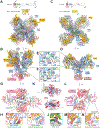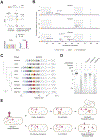Prokaryotic innate immunity through pattern recognition of conserved viral proteins
- PMID: 35951700
- PMCID: PMC10028730
- DOI: 10.1126/science.abm4096
Prokaryotic innate immunity through pattern recognition of conserved viral proteins
Abstract
Many organisms have evolved specialized immune pattern-recognition receptors, including nucleotide-binding oligomerization domain-like receptors (NLRs) of the STAND superfamily that are ubiquitous in plants, animals, and fungi. Although the roles of NLRs in eukaryotic immunity are well established, it is unknown whether prokaryotes use similar defense mechanisms. Here, we show that antiviral STAND (Avs) homologs in bacteria and archaea detect hallmark viral proteins, triggering Avs tetramerization and the activation of diverse N-terminal effector domains, including DNA endonucleases, to abrogate infection. Cryo-electron microscopy reveals that Avs sensor domains recognize conserved folds, active-site residues, and enzyme ligands, allowing a single Avs receptor to detect a wide variety of viruses. These findings extend the paradigm of pattern recognition of pathogen-specific proteins across all three domains of life.
Conflict of interest statement
Figures







Comment in
-
STAND alert! Prokaryotic immunity for recognition and defense against bacteriophages.Trends Microbiol. 2022 Dec;30(12):1128-1130. doi: 10.1016/j.tim.2022.10.004. Epub 2022 Oct 19. Trends Microbiol. 2022. PMID: 36272886
References
-
- Hampton HG, Watson BNJ, Fineran PC, The arms race between bacteria and their phage foes. Nature. 577, 327–336 (2020). - PubMed
MeSH terms
Substances
Grants and funding
LinkOut - more resources
Full Text Sources
Other Literature Sources
Molecular Biology Databases
Research Materials

